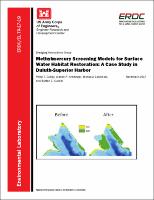Please use this identifier to cite or link to this item:
https://hdl.handle.net/11681/25606Full metadata record
| DC Field | Value | Language |
|---|---|---|
| dc.contributor.author | Gidley, Philip T. | - |
| dc.contributor.author | Kreitinger, Joseph P. | - |
| dc.contributor.author | Zakikhani, Mansour, 1954- | - |
| dc.contributor.author | Suedel, Burton C. | - |
| dc.date.accessioned | 2017-11-27T16:20:13Z | - |
| dc.date.available | 2017-11-27T16:20:13Z | - |
| dc.date.issued | 2017-11 | - |
| dc.identifier.uri | http://hdl.handle.net/11681/25606 | - |
| dc.identifier.uri | http://dx.doi.org/10.21079/11681/25606 | - |
| dc.description.abstract | The placement of dredged material for creating vegetated shallow water aquatic habitat is being assessed for changes in long-term bioavailability of mercury (Hg) to wildlife and humans. The three models used in this study (HERMES, WASP, and SERAFM) were applied in different ways to explore the possible strengths of each model, rather than to make direct comparisons between models. The HERMES model, which was most explicitly changed to account for aquatic plant growth, showed the greatest increases in sediment methylmercury (MeHg). The WASP model, which was most likely simulating a situation where dredged material is placed and aquatic plants do not grow, showed the least overall changes in surface water and sediment MeHg. The SERAFM model, which had the least “flushing” of the surface water in the restored scenario, showed the greatest increases in surface water MeHg (despite entered reductions in sediment Hg). This study focused on the usefulness of each of the models separately for their ability to predict long-term MeHg changes in sediment, sediment porewater, surface water (including suspended particulates), and dissolved-in-surface water after the creation of shallow water habitat, relative to a “no-action” scenario at the site. | en_US |
| dc.description.sponsorship | Engineering With Nature Program (U.S.) | en_US |
| dc.language.iso | en | en_US |
| dc.publisher | Environmental Laboratory (U.S.) | en_US |
| dc.publisher | Engineer Research and Development Center (U.S.) | en_US |
| dc.relation.ispartofseries | ERDC/EL;TR-17-19 | - |
| dc.subject | Duluth-Superior Harbor | en_US |
| dc.subject | Habitat restoration | en_US |
| dc.subject | Mercury | en_US |
| dc.subject | Screening models | en_US |
| dc.subject | HERMES | en_US |
| dc.subject | SERAFM | en_US |
| dc.subject | WASP | en_US |
| dc.subject | Duluth (Minn.)--Harbor; Superior (Wis.)--Harbor | en_US |
| dc.subject | Dredging spoil | en_US |
| dc.subject | Contaminated sediments | en_US |
| dc.subject | Methylmercury | en_US |
| dc.subject | Aquatic plants--Effect of sediments on estuarine restoration | en_US |
| dc.subject | Environmental sciences--Mathematical models | en_US |
| dc.title | Methylmercury screening models for surface water habitat restoration : a case study in Duluth-Superior Harbor | en_US |
| dc.type | Report | en_US |
| Appears in Collections: | Technical Report | |
Files in This Item:
| File | Description | Size | Format | |
|---|---|---|---|---|
| ERDC-EL TR-17-19.pdf | 1.17 MB | Adobe PDF |  View/Open |